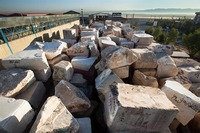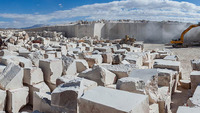The stone industry refers to the sector involved in the extraction, processing, manufacturing, and distribution of natural stones such as marble, granite, limestone, slate, and sandstone. This industry encompasses a wide range of activities, including quarrying, cutting, shaping, polishing, and finishing stones for various applications.
The stone industry plays a significant role in construction, architecture, interior design, landscaping, and even art. Natural stones are used for building facades, flooring, countertops, monuments, sculptures, and decorative elements in both residential and commercial projects.
Key players in the stone industry include stone quarries, stone processing factories, manufacturers of stone products, distributors, and retailers. The industry employs a diverse range of machinery and techniques to extract, process, and fabricate stones, including diamond wire saws, block cutters, bridge saws, CNC machines, and waterjet cutting systems.
Overall, the stone industry contributes to the economy by providing materials for construction projects, creating jobs, and supporting related sectors such as architecture, design, and landscaping.
The stone industry export refers to the international trade of natural stones and stone products, including marble, granite, limestone, slate, sandstone, and various manufactured stone items. Stone industry exports can encompass a wide range of products, from raw stone blocks and slabs to finished products such as tiles, countertops, sculptures, and architectural elements.
Countries with abundant natural stone resources often engage in stone industry exports to capitalize on their natural assets and generate revenue. These exports may involve both raw materials and value-added products, depending on the capabilities and expertise of the exporting country.

Exporting countries
Stone industry exports can benefit both exporting countries and importing nations. Exporting countries can earn foreign exchange, create employment opportunities, and stimulate economic growth by tapping into international markets for their stone products. Importing countries, on the other hand, gain access to high-quality natural stones for construction, decoration, and other purposes.
Key factors influencing stone industry exports include the quality and variety of available stone resources, production capacity, technological capabilities for processing and fabrication, transportation infrastructure, trade policies, and market demand. Additionally, factors such as currency exchange rates, tariffs, and regulatory requirements can also impact the competitiveness of stone industry exports in the global market.
"Stone air export" refers to the transportation of stone products via air freight for international trade purposes. While air transport is not as commonly used for heavy or bulky stone materials compared to sea or land transport, it can be advantageous for certain types of stone products or in specific situations where speed is essential.
Stone air exports may include high-value or time-sensitive items such as small quantities of premium-quality stones, customized or bespoke stone products, samples for exhibitions or showcases, or urgent orders for construction or restoration projects.
Despite its advantages in terms of speed and efficiency, air transport for stone products may be limited by factors such as weight restrictions, size constraints, and higher costs compared to other modes of transportation. Additionally, proper packaging and handling are crucial to ensure the safe transportation of stone products by air.
Overall, while air transport may not be the primary choice for stone industry exports due to logistical considerations, it can still play a valuable role in meeting specific market demands or urgent delivery requirements.
different kinds of stones
There are numerous types of stones found in nature, each with its unique characteristics, colors, textures, and applications. Some of the different kinds of stones commonly used in various industries include:
1. Granite: Known for its durability, hardness, and resistance to scratches and heat, granite is a popular choice for kitchen countertops, flooring, and building facades.
2. Marble: Recognized for its elegance and beauty, marble comes in a variety of colors and is often used in sculptures, flooring, countertops, and decorative elements.
3. Limestone: Limestone is a sedimentary rock composed mainly of calcium carbonate. It is used in architecture, construction, and as a raw material for cement production.
4. Sandstone: Sandstone is a sedimentary rock formed from sand grains and minerals. It is valued for its natural beauty and is commonly used in building facades, paving, and landscaping.
5. Slate: Slate is a fine-grained metamorphic rock that is commonly used for roofing, flooring, and decorative purposes due to its durability and attractive appearance.
6. Travertine: Travertine is a type of limestone formed by the precipitation of minerals from hot springs. It is often used in flooring, countertops, and wall cladding.
7. Quartzite: Quartzite is a hard, metamorphic rock composed mainly of quartz grains. It is valued for its durability and resistance to heat and is commonly used in countertops, flooring, and wall cladding.
8. Basalt: Basalt is a dark-colored igneous rock commonly used in construction and landscaping due to its strength and durability.
9. Onyx: Onyx is a type of calcite mineral formed in caves. It is valued for its translucent properties and is often used in decorative items such as countertops, wall cladding, and lighting fixtures.
These are just a few examples of the many types of stones found in nature, each with its unique characteristics and applications in various industries.
several advantages
Stone export by sea is a common method of transporting bulk quantities of stone products from one country to another. This method offers several advantages, including:
1. Cost-effectiveness: Shipping by sea is often more cost-effective than air freight or other modes of transportation, especially for heavy and bulky stone materials.
2. Capacity: Sea vessels have large cargo capacities, allowing for the transportation of significant quantities of stone products in a single shipment.
3. Accessibility to Ports: Many countries have well-established port infrastructure, making it convenient to export stone products by sea from locations near stone quarries or processing facilities.
4. Versatility: Sea transport can accommodate various types of stone products, including raw materials such as stone blocks and slabs, as well as finished products like tiles, countertops, and sculptures.
5. Global Reach: Shipping by sea enables stone exporters to access markets worldwide, reaching distant destinations across continents.
6.Reliability: Despite longer transit times compared to air transport, shipping by sea is generally reliable, with scheduled departures and arrivals, and fewer disruptions due to weather conditions.
7. Environmental Impact: Sea transport tends to have a lower carbon footprint compared to air freight, making it a more environmentally friendly option for stone export.
However, there are also challenges associated with stone export by sea, including longer transit times, potential for delays due to port congestion or customs procedures, and risks such as damage or loss of cargo during transit. Effective packaging, proper documentation, and working with experienced shipping partners are essential to mitigate these risks and ensure successful stone export by sea.

Stones have a wide range of uses across various industries and applications due to their durability, versatility, and aesthetic appeal.
Some common usages of stones
1. Construction: Stones are widely used in construction for building facades, walls, foundations, pavements, and landscaping. They provide structural integrity, stability, and visual appeal to buildings and outdoor spaces.
2. Interior Design: Stones are used in interior design for flooring, wall cladding, countertops, fireplaces, and decorative features. They add texture, color, and character to indoor spaces, creating a timeless and sophisticated ambiance.
3. Monuments and Sculptures: Stones have been used for centuries to create monuments, sculptures, statues, and memorials. They are valued for their durability, allowing for the preservation of artistic and historical landmarks.
4. Infrastructure: Stones are essential materials for infrastructure projects such as bridges, dams, roads, railways, and tunnels. They provide strength, stability, and longevity to these critical structures.
5. Landscaping: Stones are used in landscaping for pathways, patios, retaining walls, water features, and garden borders. They add natural beauty, texture, and structure to outdoor environments, enhancing curb appeal and functionality.
6. Industrial Applications: Stones are utilized in various industrial applications such as abrasive materials for grinding, polishing, and cutting; refractory materials for high-temperature environments; and filtration media for water and air purification.
7. Art and Craftsmanship: Stones are valued by artists, craftsmen, and artisans for their workability and aesthetic qualities. They are carved, sculpted, engraved, and shaped into decorative objects, jewelry, and artistic creations.
8. Functional Uses: Stones are used for practical purposes such as millstones for grinding grains, cobblestones for paving streets, gravestones for marking burial sites, and boundary stones for delineating property lines.
Overall, the diverse properties of stones make them indispensable materials in various industries and applications, contributing to both functional and aesthetic aspects of human life and civilization.